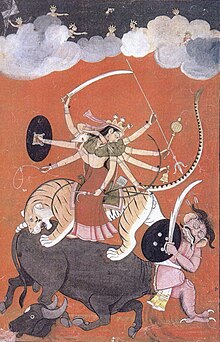| Durga | |
|---|---|
Mother Goddess; Goddess of Power, Strength and Protection | |
| Member of Pancha Prakriti | |
 18th-century painting of Durga slaying the buffalo demon Mahishasura | |
| Other names | Adi Shakti, Mahishasura Mardini, Bhagavati, Bhavani, Jagadamba |
| Devanagari | दुर्गा |
| Affiliation | Devi, Shakti, Mahadevi, Parvati, Navadurga |
| Abode | Manidvipa, Mount Kailash |
| Mantra |
|
| Weapon | Chakra (discus), Trishula (trident), Gada (mace), Bow and Arrow, Khanda (sword) |
| Day | Friday |
| Mount | Lion; Tiger[1][2] |
| Texts | Devi-Bhagavata Purana, Devi Mahatmya, Kalika Purana, Shakta Upanishads, Tantras |
| Festivals | Durga Puja, Durga Ashtami, Navaratri, Vijayadashami, Bathukamma |
| Genealogy | |
| Siblings | Vishnu[3] |
| Consort | Shiva[3][4] |
| Equivalents | |
| Manipuri | Panthoibi[5] |
| Part of a series on |
| Hinduism |
|---|
 |
Durga (Sanskrit: दुर्गा, IAST: Durgā) is a major Hindu goddess, worshipped as a principal aspect of the mother goddess Mahadevi. She is associated with protection, strength, motherhood, destruction, and wars.[6][7][8]
Durga's legend centres around combating evils and demonic forces that threaten peace, prosperity, and dharma, representing the power of good over evil.[7][9] Durga is believed to unleash her divine wrath against the wicked for the liberation of the oppressed, and entails destruction to empower creation.[10] Durga is seen as a motherly figure and often depicted as a beautiful woman, riding a lion or tiger, with many arms each carrying a weapon and often defeating demons.[2][11][12][13] She is widely worshipped by the followers of the goddess-centric sect, Shaktism, and has importance in other denominations like Shaivism and Vaishnavism.[9][14]
The most important texts of Shaktism, Devi Mahatmya and Devi Bhagavata Purana, revere Devi (the Goddess) as the primordial creator of the universe and the Brahman (ultimate truth and reality).[15][16][17] She is one of the five equivalent deities in Panchayatana puja of the Smarta tradition of Hinduism.[18][19] She is also considered to be the younger sister of Vishnu according to Bhagavata purana.[20][21][22]
Durga has a significant following all over Nepal, India, Bangladesh and many other countries. She is mostly worshipped after spring and autumn harvests, especially during the festivals of Durga Puja, Durga Ashtami, Vijayadashami, Deepavali, and Navaratri.[23][24]
- ^ Robert S Ellwood & Gregory D Alles 2007, p. 126.
- ^ a b Wendy Doniger 1999, p. 306.
- ^ a b Williams, George M. (27 March 2008). Handbook of Hindu Mythology. OUP USA. ISBN 978-0-19-533261-2.
- ^ Indian Civilization and Culture. M.D. Publications Pvt. 1998. p. 116,118. ISBN 9788175330832.
- ^ Singh, Moirangthem Kirti (1998). "Recent Researches in Oriental Indological Studies: Including Meiteilogy". Archived from the original on 19 August 2021. Retrieved 3 May 2021.
- ^ Encyclopedia Britannica 2015.
- ^ a b David R Kinsley 1989, pp. 3–4.
- ^ Charles Phillips, Michael Kerrigan & David Gould 2011, pp. 93–94.
- ^ a b Paul Reid-Bowen 2012, pp. 212–213.
- ^ Laura Amazzone 2012, pp. 3–5.
- ^ David R Kinsley 1989, pp. 3–5.
- ^ Laura Amazzone 2011, pp. 71–73.
- ^ Donald J LaRocca 1996, pp. 5–6.
- ^ Lynn Foulston & Stuart Abbott 2009, pp. 9–17.
- ^ June McDaniel 2004, pp. 215–216.
- ^ David Kinsley 1998, pp. 101–102.
- ^ Laura Amazzone 2012, p. xi.
- ^ Flood 1996, pp. 17, 153.
- ^ "Panch Dev Puja Worship". ABP (in Hindi). 17 November 2021. Archived from the original on 1 October 2022. Retrieved 17 July 2022.
- ^ "ŚB 10.4.9". Bhaktivedanta Vedabase.
- ^ "Yoga-Māyā's Prophecy and Kaṃsa's Order to Slaughter all Children [Chapter 4]". 2 September 2022.
- ^ "Yoganidra, Yoganidrā, Yoga-nidra: 14 definitions". 11 March 2017.
- ^ James G Lochtefeld 2002, p. 208.
- ^ Constance Jones & James D Ryan 2006, pp. 139–140, 308–309.